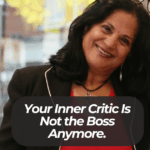Do you know that feeling when a task sits on your to-do list, haunting you? You circle, rewrite, plan, but don’t start. And you tell yourself, “I’m just lazy, unmotivated, undisciplined.” This is your procrastination talking.
You’re not.
That’s not laziness. That’s your nervous system protecting you. Procrastination isn’t resistance to work. It’s resistance to threat. And your brain has decided somewhere deep beneath logic that finishing this task isn’t safe.
Let’s take the shame out of this.
When your body associates visibility, judgment, or possible rejection with danger, “later” becomes a shield. Procrastination is how your system buys time to regulate. It’s the body’s way of whispering, “We’re not ready to feel that yet.”
Think of your stress response like a smoke alarm. It doesn’t analyse the source it just reacts. That internal alarm is sent if your brain senses potential failure, embarrassment, or exposure. You feel frozen, distracted, or suddenly drawn to doing dishes instead of your sales page. You call it avoidance; your body calls it protection.
High-achievers procrastinate too, just differently.
You will stay busy, but avoid the right things, the critical, meaningful, visibility-linked things. You will redesign the website, re-edit the course, and fine-tune the offer deck, but we don’t hit publish.
Not because we don’t know how, but because the task threatens an old wound: “What if I’m not enough?”
So procrastination isn’t a time management flaw. It’s a trauma echo. It’s your system saying, “Doing this could hurt.”
A story from the field…
A woman I worked with had been “about to launch” her program for almost a year. Every time she got close to finishing, she’d suddenly need to redo her slides or “clarify her message.” She wasn’t flaky. She was afraid. Her nervous system linked visibility with danger.
As a child, success meant jealousy or criticism at home. So subconsciously, staying almost ready felt safer than being fully seen. We reframed her procrastination as a nervous system alarm, not a personal failure.
When she stopped fighting it, something softened. She asked, “What part of me doesn’t feel safe right now?” That question turned procrastination into dialogue, not battle.
Every form of avoidance has a story.
Some of us avoid because we fear failure. Others avoid because success would raise expectations. Many avoid because visibility feels like exposure. The common thread? Procrastination protects the version of you that once had no power over the outcome.
The biology behind procrastination
When the brain anticipates a task that carries emotional risk, it activates the threat response. Heart rate increases, cortisol rises, and blood flow moves away from the prefrontal cortex, the part responsible for decision-making and focus.
That’s why you suddenly “can’t think.” Your system has shifted from creation to protection.
So when you say, “Just focus!” you’re demanding that your body perform in self-defence mode. No wonder it rebels. The fix isn’t discipline. It’s safety.
How to build micro-safety into the start. Say out loud, “It’s okay to take five minutes.”
Lower the bar until your body says, “I can do that.”
Keep your nervous system company as you start.
That small start is enough to disarm the internal alarm. The goal isn’t to finish, it’s to reintroduce trust. Your brain needs to see that starting doesn’t equal danger.
I had another client who ran a growing service business but froze every time she had to send proposals. She’d open her laptop, stare at the document, feel her chest tighten, and clean the kitchen instead. Her pattern wasn’t disorganisation but fear of rejection replaying through muscle memory.
When we unpacked it, she remembered being ridiculed in school for getting something “wrong” in public. That memory still lived in her body, and every client proposal re-triggered the same threat.
We didn’t push her to “be brave.” We paired action with safety. She started with one sentence per proposal, then paused to breathe and shake out her hands. Her brain learned: “I can be visible and survive it.” Within a month, she was sending proposals without panic. Safety reinstalled focus.
Procrastination points to where your body needs safety.
Instead of asking, “How do I stop procrastinating?” ask, “What danger does my body think I’m avoiding?”
Maybe it’s embarrassment. Perhaps it’s perfectionism as protection: “If I get it perfect, I won’t get hurt.” Perhaps you’re afraid that if this succeeds, you’ll have to maintain it forever and lose your rest.
Here’s how to rewire that response: Start smaller than you think. Your nervous system doesn’t trust leaps it trusts steps.
Name the fear out loud. Saying, “I’m scared to be seen,” moves it from implicit memory to explicit language, downregulating the threat. Close the loop gently. When you finish a small task, pause for a moment of acknowledgement. Let your body feel the safety of completion instead of sprinting to the next thing.
When your body begins to associate action with safety rather than threat, procrastination naturally loses its function.
The next time you’re delaying something big… Don’t bully yourself into motion. Sit with the delay and ask, “What am I protecting myself from?”
Maybe it’s embarrassment, exposure, or disappointment. Then thank the part of you that’s trying to help. Literally say, “Thank you for trying to keep me safe. We can move now.”
You build internal trust by including your fear, not overriding it.
Procrastination ends when safety begins.
When your system trusts that you can start, fail, succeed, and still be safe, urgency becomes a choice. You don’t need more motivation. You need nervous system alignment.
So the next time you catch yourself scrolling or cleaning instead of creating, pause. Take a breath. Put your hand on your heart and say, “I’m safe to start small.” Then do the task’s most miniature, least threatening version: a 2-minute outline, one message draft, and a single paragraph. Let that be enough.
You are not lazy or inconsistent. You are self-protective and your body has just been working from an outdated definition of danger.
Say this with me: “I don’t procrastinate because I’m weak. I pause because my body is asking for safety first.” And safety is what builds sustainable action.
Bring this into your Habit Rejection workbook. Each day, note one task you delayed and one emotion underneath it. Don’t judge, just witness. Awareness is the start of regulation.
Ready to build a business that runs on calm, not cortisol?
Join the Reset & Rewire Masterclass FREE. We’ll map your nervous system’s “start pattern” and help you design momentum that feels safe to sustain.
The Inner CEO Rewire Accelerator is live now. Apply to join.






